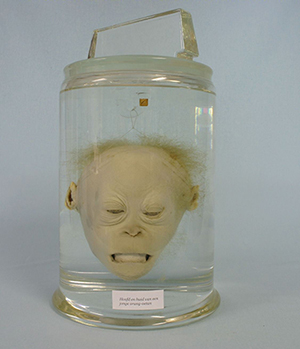head of a young orang utan

This young orang utan is one of the first great apes ever researched in the West. It’s one of the two specimens that Petrus Camper dissected in 1770 and 1771 in public anatomy lessons in Groningen.
The anatomy of apes was of great scientific interest in the second half of the eighteenth century. Scientists not only tried to determine different species, but also wanted to know how apes differed from humans.
The first two animals were already dead when they ended up on Camper’s dissecting table. Their intestines had withered to mush. So he set his heart on the living animal that arrived at the zoo of stadtholder Willem V in 1776. Camper was promised that the animal would be transported to Groningen as soon as it died.
However, when the animal indeed passed away after seven months, the zoo’s supervisor quickly took it apart so he could stuff the body. The anatomist from Groningen was furious. In a scathing letter he wrote that not only himself, but all of Europe had been robbed of the chance to examine the brains of this ‘infamous and peculiar Animal’.
The stadtholder intervened and so Camper was given the animal’s the torso to dissect. The fight went down in history as the ‘orang utan war’. It took years for the men to reconcile.

